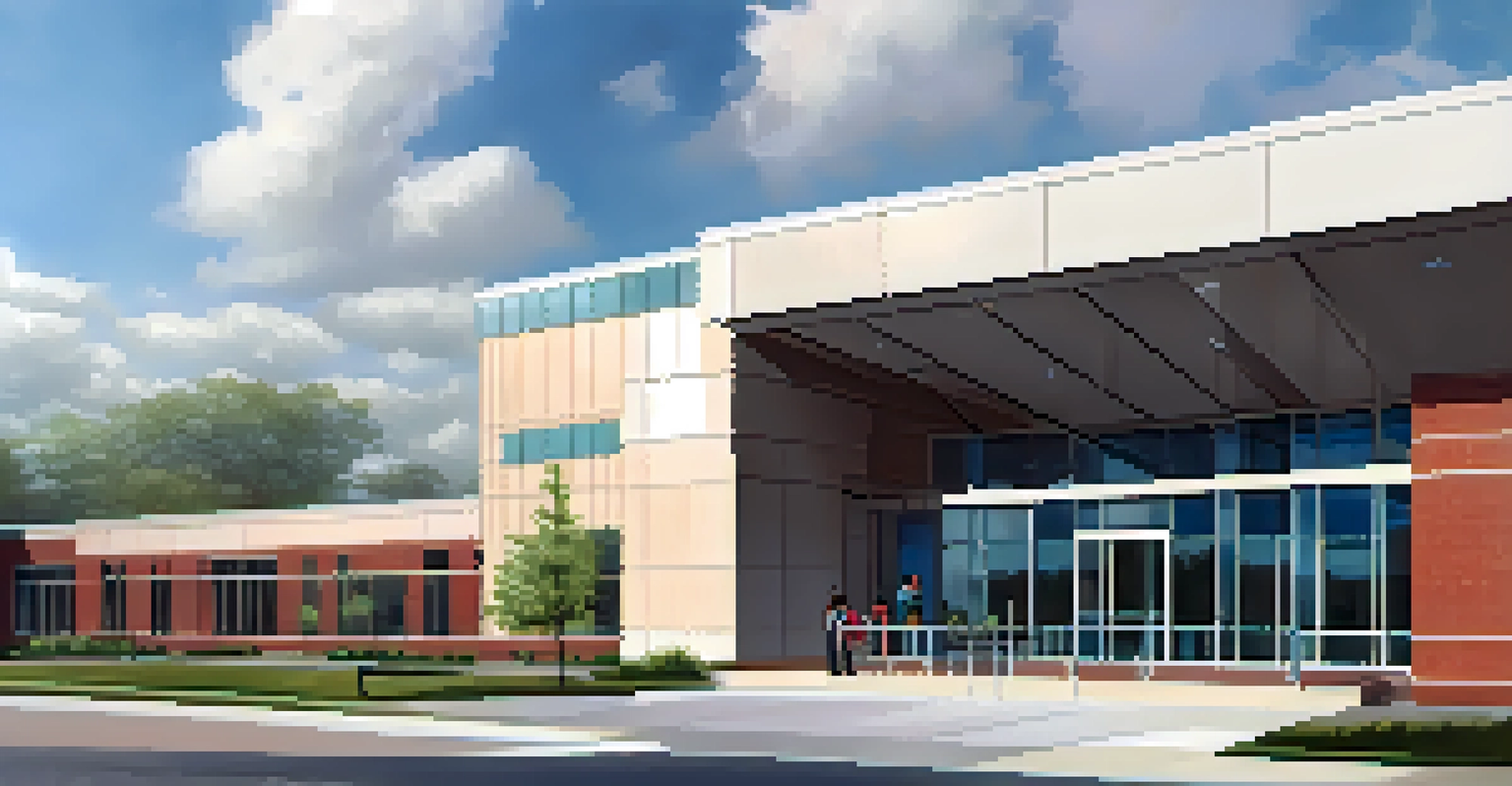Exploring Missouri's Healthcare System: Key Features and Trends

Overview of Missouri's Healthcare System Structure
Missouri's healthcare system is a complex network that includes public and private hospitals, clinics, and specialty care facilities. The state is home to a mix of urban and rural healthcare providers, which impacts accessibility and quality of care. Understanding the structure helps patients navigate their options and find the best resources for their needs.
Health equity is not a privilege, but a right for all individuals, regardless of their socioeconomic status or location.
In urban areas like St. Louis and Kansas City, healthcare access is generally more robust, with numerous hospitals and specialized services. Conversely, rural regions often face challenges such as fewer providers and longer travel distances to receive care. This disparity highlights the importance of addressing healthcare equity across the state.
The Missouri Department of Health and Senior Services plays a crucial role in overseeing the healthcare landscape, ensuring compliance and quality standards. Their ongoing efforts to improve healthcare delivery are essential in managing the state's diverse population and addressing public health concerns.
Key Players in Missouri's Healthcare System
Several key players shape Missouri's healthcare landscape, including major hospital systems like BJC HealthCare and Mercy Health. These organizations not only provide a wide range of services but also engage in community outreach and health education initiatives. Understanding these players can help residents make informed choices about their healthcare.

In addition to hospitals, primary care physicians and specialists contribute significantly to the state's healthcare ecosystem. Many areas also benefit from federally qualified health centers (FQHCs), which offer essential services to underserved populations. These centers are vital in bridging gaps in care, especially in rural communities.
Missouri's Healthcare Landscape
Missouri's healthcare system includes a mix of urban and rural providers, impacting accessibility and quality of care.
Insurance providers also play a crucial role, influencing the accessibility and affordability of healthcare services. Missouri has a mix of private insurers and public programs like Medicaid, which cater to different segments of the population. Navigating these options can be daunting, but understanding the landscape is key to finding suitable coverage.
Missouri's Medicaid Expansion and Its Impact
In 2020, Missouri voters approved the expansion of Medicaid under the Affordable Care Act, a significant change for the state's healthcare system. This expansion aimed to provide healthcare access to an estimated 230,000 low-income residents. Understanding the implications of this decision is crucial for both providers and patients.
Technology is best when it brings people together, especially in healthcare, where connection can mean the difference between life and death.
The expansion has led to increased enrollment in Medicaid, resulting in more residents gaining access to essential healthcare services. This shift not only benefits individuals but also supports local economies, as more funds flow into healthcare providers. The ripple effects of this change are felt across various sectors.
However, challenges remain, such as ensuring adequate funding and addressing the needs of newly eligible populations. Ongoing discussions about budget allocations and healthcare delivery models will be central to the success of this initiative. Stakeholders must work collaboratively to ensure that the promise of Medicaid expansion is fully realized.
Telehealth Trends in Missouri's Healthcare System
The COVID-19 pandemic accelerated the adoption of telehealth services in Missouri, transforming how patients access care. Telehealth offers convenience and flexibility, allowing individuals to consult with healthcare providers from the comfort of their homes. This trend is particularly beneficial for those in rural areas with limited access to specialists.
Missouri has seen a significant increase in telemedicine visits, with many providers now offering virtual appointments as a standard practice. This shift not only improves access but also enhances patient experience by reducing wait times and travel-related stress. However, it raises questions about the digital divide and access to technology.
Medicaid Expansion Benefits
The expansion of Medicaid in Missouri has increased access to healthcare for low-income residents and supported local economies.
Regulatory changes have also played a role in expanding telehealth services, with the state relaxing certain restrictions to facilitate remote care. As Missouri continues to embrace this trend, ongoing evaluation of its effectiveness and accessibility will be essential in shaping the future of healthcare delivery.
Addressing Health Disparities in Missouri
Health disparities remain a pressing issue in Missouri, with certain populations facing significant barriers to care. Factors such as socioeconomic status, race, and geographic location contribute to unequal health outcomes. Addressing these disparities is crucial for creating a more equitable healthcare system.
Organizations across the state are actively working to tackle these challenges through outreach programs, education, and policy advocacy. For example, initiatives aimed at increasing access to preventive care and health screenings can help mitigate disparities. These efforts are vital in building a healthier, more informed community.
Collaboration between healthcare providers, community organizations, and policymakers is essential in addressing these issues effectively. By working together, stakeholders can develop targeted strategies that empower underserved populations and promote health equity. The journey toward equality in healthcare is ongoing, but progress is being made.
Emerging Technologies in Missouri Healthcare
Emerging technologies are playing a transformative role in Missouri's healthcare system, enhancing patient care and operational efficiency. Innovations like electronic health records (EHRs), artificial intelligence (AI), and wearable devices are becoming increasingly integrated into healthcare practices. Understanding these technologies can help patients make informed choices about their care.
AI, for instance, is being utilized to analyze patient data and improve diagnostic accuracy, enabling providers to deliver personalized treatment plans. Similarly, telemedicine platforms are incorporating advanced features that enhance patient-provider communication. These advancements pave the way for a more responsive and patient-centered healthcare experience.
Telehealth's Growing Importance
The rise of telehealth services in Missouri has improved access to care, especially for residents in rural areas, despite challenges like the digital divide.
While the potential benefits are substantial, it is essential to address challenges such as data privacy and security. Ensuring that patient information remains confidential is paramount as healthcare organizations adopt new technologies. Ongoing dialogue about ethical considerations will be crucial as Missouri's healthcare system continues to evolve.
Future Trends in Missouri's Healthcare System
As we look ahead, several trends are likely to shape the future of Missouri's healthcare system. A growing emphasis on preventative care and wellness programs is expected, as healthcare providers recognize the importance of addressing health issues before they escalate. This proactive approach can lead to improved health outcomes and reduced costs for both individuals and the system as a whole.
Additionally, the integration of mental health services into primary care settings is gaining traction, reflecting a more holistic approach to health. By breaking down silos between physical and mental health, providers can offer comprehensive care that addresses the whole person. This trend is especially relevant in a world where mental health awareness is on the rise.

Finally, ongoing discussions about healthcare policy and funding will play a critical role in shaping Missouri's healthcare landscape. Stakeholders must remain engaged to advocate for reforms that support access, equity, and innovation. The future of Missouri's healthcare system is bright, but it requires collaboration and commitment from all involved.